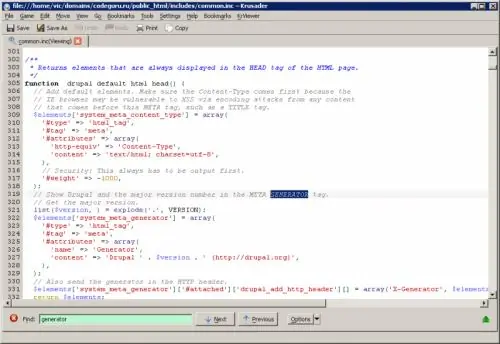- Author Lauren Nevill [email protected].
- Public 2023-12-16 18:48.
- Last modified 2025-01-23 15:15.
The HEAD section of HTML or XHTML web pages can include META elements containing arbitrary information. This may include an element with a name attribute set to generator. The content of the content attribute of this element indicates the means by which the page was generated. For security reasons, many webmasters prefer to remove this element from the pages of their sites.

It is necessary
- - access to the administrative panel of the CMS;
- - access to the site server via FTP;
- - text editor with the ability to save in common encodings.
Instructions
Step 1
Disable the output of the meta tag with the name property set to generator in the settings of the content management system used. If the site operates on the basis of a modern CMS, then this functionality, most likely, can be disabled by administration tools.
Log in to the CMS control panel with an administrator account or a user with the rights to change system settings. Go to the appropriate section. Disable meta tag output.
The way to form and change the content of the HEAD element of the page depends on the type of CMS. It may be enough to disable one of the options to block the output of a certain tag. You may have to deactivate some add-on module or manually edit the list of meta tags.
Step 2
Remove the meta tag with name equal to generator by editing the page title template of the current CMS-powered website theme. As a rule, content management systems form the required set of meta-tags and add it to the headers of the generated pages. But any tags can be hardcoded into templates.
Download the page header template file for the current site theme to your local disk using FTP. Change it in a text editor. Upload this file back to the server replacing the original.
Step 3
Remove the output of the meta tag from the name generator in the site page headers by modifying the source code files of the content management system. In some CMS, the meta-tag that identifies the engine is forcibly added to the set of meta-tags of all pages, so you can't do without editing the code.
Unpack the CMS distribution to a temporary folder on the local computer disk or download the engine files from the server using an FTP client. Search for the generator snippet in the content of the CMS files. Browse the found files, study the source code. Comment out the code fragments responsible for displaying the required meta tag. Replace the CMS files on the server with their modified versions.

Step 4
Remove the meta name generator from your static site pages. Download the files for the pages that contain this tag from the site server to a temporary location on your computer's hard drive. Use an FTP client program. Edit the files by excluding the desired meta tag from the HEAD section. Use a text editor that can save the files in their original encoding. Upload the changed files to the server.






